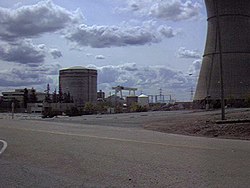Pressurized water reactor
Pressurized water reactors (PWRs) form the large majority of the world's nuclear power plants. In a PWR, the coolant (water) is pumped under high pressure to the reactor core where it is heated by the energy released by the fission of atoms. Pressure in the primary coolant loop prevents the water from boiling within the reactor. The heated water then flows to a steam generator where it transfers heat to a secondary system where steam is generated. The steam flows to a steam turbine which spins an electric generator. The used steam is condensed and returned to the steam generator for re-use. PWRs use ordinary water as both coolant and neutron moderator.
Pressurized Water Reactor Media
Rancho Seco PWR reactor hall and cooling tower (being decommissioned, 2004)
Primary coolant system showing reactor pressure vessel (red), steam generators (purple), Pressurizer (blue), and pumps (green) in the three coolant loop Hualong One design
PWR fuel bundle This fuel bundle is from a pressurized water reactor of the nuclear passenger and cargo ship NS Savannah. Designed and built by Babcock & Wilcox.




